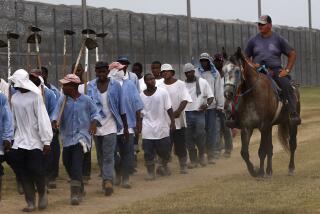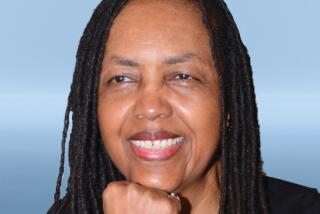Whitney Plantation in Wallace, La., puts focus on slavery
- Share via
WALLACE, La. — “Imagine what it would feel like to be someone else’s property,” said Monique Washington Johnson. Our guide looked directly at the nine men and women walking with her on the grounds of Whitney Plantation on a steamy March afternoon.
“Imagine you are a field slave,” she said. “You wake up before sunrise. You work until dark, which is 8 or 9 in hot and humid summers. Your life depends on the whims of your master or mistress.
“Imagine you have no autonomy over your life. There is no way to know if your child will be sold or if your wife will be beaten.”
The 90-minute tour at Whitney Plantation, which opened Dec. 7, is like no other at plantations along the Mississippi River between New Orleans and Baton Rouge, La. Most tourist plantation guides now mention slavery, an uncomfortable topic for some in this area. But their focus is on the grandeur of the houses and their antiques, with visitors experiencing the hoop-skirt version of Southern history.
Whitney’s brochure states its mission: “The Story of Slavery.”
“We are not here to judge or place blame, but to honor those people who did not have a voice,” say guides at Whitney, about an hour west of New Orleans.
Ashley Rogers, director of operations, and Ibrahima Seck, a historian who moved to New Orleans from Senegal to be director of research, wrote the script for the tour.
“There are no records of owners saying, ‘This is how I treat my slaves,’ but the script is aligned with what we do know,” Rogers said. “It’s all backed up by bills of sale, newspaper ads, documents, post-Civil War interviews with slaves and diaries.”
There are 2,700 oral histories in the Library of Congress, many from a 1930s Works Progress Administration writers’ project that interviewed former slaves who were children when the Civil War ended in 1865.
Seck, a former Fulbright scholar, studied a survey of Whitney that Louisiana State University did for its previous owners, a petrochemical company that planned to build a factory on the plantation site but was stopped by public protests.
His new book, “Bouki Fait Gombo,” is about slaves on Whitney, and he said his goal is “to find information about slavery and do an analysis that’s available to the public everywhere [online].”
Rogers, a former house museum director, was hired in September by John Cummings, 77, a real estate investor and former trial lawyer. The self-described “rich white guy” owns Whitney and everything on it.
He bought the 250-acre plantation from the petrochemical company in 1998 but had no clue what to do with it. Then he read the LSU survey and saw a need to educate people about slavery.
“It’s a very sacred place,” said Cummings, who was a civil rights activist and is a believer in progressive causes.
“It’s important everyone knows that all these beautiful homes were built by slaves,” he told me. “The slaves did the work. They endured and they died.”
German immigrants, the Heidels (also spelled “Haydel”), bought the land in 1752. They owned it and other nearby plantations, growing indigo and then sugar cane from 1752 to 1867. Its second owner named it Whitney, after his grandson.
Cummings said he’s spent $8million of his own money on Whitney, which is a work in progress. Seven slave cabins are on the plantation, and there are plans to have recordings tell the stories of slaves as visitors walk among the buildings.
The big house at Whitney has been restored and decorated with period furniture. Even here, guides talk more about the lives of the house slaves, who worked nearly around the clock and slept on pallets on the floor.
Mothers rarely saw their children, Johnson said. “I want people to understand the emotional abuse endured by slaves in the big house,” she said later.
In a church moved onto the grounds are artist Woodrow Nash’s life-size clay statues of children who might have been slaves at Whitney. Their empty eyes are haunting in frail bodies and rag clothes.
Cummings commissioned sculptor Rod Moorhead to create a bronze statue of a black angel cradling a baby in her arms before taking him to heaven. It’s the centerpiece of a circular brick patio called Field of Angels and a tribute to 2,200 slave children who died in St. John the Baptist Parish, where Whitney is. Their names are engraved on waist-high granite tablets.
The patio is near 216 granite slabs on 18 walls, a memorial to all slaves who lived in Louisiana. The names of 107,000 who were brought here between 1719 and 1820 and were included in the Louisiana Slave Database are listed here along with harrowing personal stories and pictures.
And yet another memorial, the Wall of Honor, pays homage to 354 slaves owned by the Haydel family.
“Coming soon,” Cummings said, is a display representing the heads of slaves executed by slave owners after an 1811 rebellion nearby.
The re-creations will be posted on spikes where children and other visitors can avoid seeing them, he said.
“Some say that’s too shocking,” I said.
“It’s in the eye of the beholder,” he said.
::
If you go
THE BEST WAY TO WHITNEY PLANTATION, WALLACE, LA.
From LAX, Delta, Southwest and United offer nonstop service to New Orleans, and United, American, Southwest and Delta offer connecting service (change of planes). Restricted round-trip airfare from $456, including taxes and fees.
Whitney Plantation is about 32 miles from the New Orleans airport. Take Interstate 10 west toward Baton Rouge. Take Louisiana 641 S exit 194 toward Gramercy. Cross Luling Bridge (LA 641 S) and take the LA 18 ramp toward Edgard/Vacherie. Turn right onto Louisiana 18 (Great River Road). Whitney is one mile down on the right.
Whitney Plantation, 5099 Highway 18, Wallace, La.; (225) 265-3300, https://www.whitneyplantation.com. Open daily 9:30 a.m to 4:30 p.m. Closed Tuesdays and major holidays. Tours are on the hour from 10 a.m. to 3 p.m. Advance reservations are recommended. Tours cost $22; $15 for students with ID, military, those age 65 and older; free for children under age 12. They are 90 minutes, all on foot and largely on gravel paths. Those with special needs should call in advance.
WHERE TO STAY
International House, 221 Camp St., New Orleans; (504) 553-9550, https://www.ihhotel.com. The 117-room boutique hotel, three blocks from the French Quarter, is stylish, with New Orleans and Louisiana art and furniture. Loa, its popular lounge, serves craft cocktails. Doubles from $273, depending on dates.
Oak Alley Plantation, 3645 Highway 18 (Great River Road), Vacherie, La.; (225) 265-2151, https://www.oakalleyplantation.com. Five century-old cottages are available for overnight stays on the grounds of Oak Alley, about nine miles north of Whitney. Wi-Fi, kitchen facilities and breakfast. There is no dinner service at Oak Alley, but guests can pre-order dinner. No smoking, no pets. Plantation tour is extra. Rates are $145-$200 a night.
WHERE TO EAT
B&C Seafood Market and Cajun Restaurant, 2155 Highway 18, Vacherie, La.; (225) 265-8356. Down-home restaurant on the Great River Road is popular for fried green tomatoes, fried seafood and alligator, crawfish, po’ boys, boudin balls and andouille. Rustic, old-country store ambience.
Oak Alley Plantation Restaurant (see above), (225) 265-2487. Lunch daily from 11 a.m. to 3 p.m. Gumbo, seafood au gratin, crawfish étouffee. Also Plantation Cafe, open 9 a.m. to 5 p.m. for lighter fare. $9.95-$17.95.
TO LEARN MORE
Louisiana Department of Tourism; (225) 342-8100, www.louisianatravel.com
For tourist guides, go to www.neworleansonline.com and www.neworleanscvb.com.
More to Read
Sign up for The Wild
We’ll help you find the best places to hike, bike and run, as well as the perfect silent spots for meditation and yoga.
You may occasionally receive promotional content from the Los Angeles Times.






